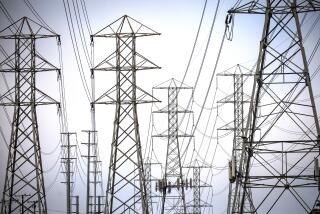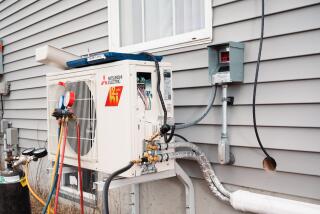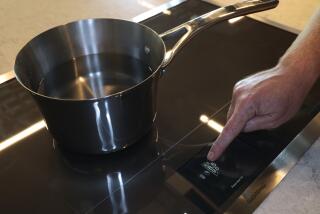UTILITIES : Little Cost-Cutters Generate Warm Feelings on Bill-Paying Day
- Share via
Some houses simply take more energy to run than others, but the worst of them can be made better by do-it-yourself efforts.
A number of low-cost and no-cost energy conservation practices can help nibble sizable chunks off your utility bills.
You can begin by reducing your water-heater temperature to 120 degrees Fahrenheit.
Install water-flow restricters on shower heads, install insulation behind electrical outlets and switch plates and add insulation over the attic stairs.
A faucet leak, small as it may be, is an energy waster. The fix may be as simple as a new washer. An often overlooked measure is vacuuming dusty baseboard heaters.
Other low-cost practices include lowering the thermostat on the heater to 55 degrees when your family is out of the house for four hours or more.
An estimated value of energy-saving measures to reduce heat loss and cold-air infiltration through the roof, walls, floor, windows and doors would include items such as these:
* Caulking that costs about $50 to install can net a $250 first-year savings, or a two-month pay-back time;
* Weatherstripping that costs $20 to install can net $35 first-year savings, or a seven-month pay-back;
* Interior storm windows that cost $230 to install can save $53 the first year and give pay-back in 4 1/3 years;
* Attic insulation that costs $60 to install can save $40 the first year and pay for itself in 1 1/2 years.
* Water heater insulation that costs $15 can save $30 in a year, paying for itself in six months.
Costs and pay-back time vary depending on your situation, but these typical examples give an idea of the benefits you can expect.
Some simple but laborious jobs are worth learning, such as installing switch-plate insulation and weatherstripping.
Others, such as insulating an attic or, even harder, an outside wall, are probably jobs for a professional, although some super-handy homeowners with time at their disposal might be able to handle them.
Additional energy-saving measures that you may be able to handle, or hire a professional to handle for you, may include sloping the earth away from the house on all sides.
This will keep out water and moisture so the heating equipment can work more efficiently.
To better control heat use, consider a zone system. Dividing zones can sometimes be done by just installing doors at both ends of a long central hall.
If you have a fireplace, installing a fireplace insert in the central heating zone can greatly increase wood-burning efficiency while cutting heat loss up the chimney when not in use. Spot heating from portable heaters may also save energy.
If you have separate bedroom wings, consider replacing the central water heater by two separate smaller ones in the attic.
One over each wing would shorten hot water lines. One would be near the kitchen as well as its bedrooms.
The shorter lines would not lose as much heat, which would greatly reduce water heating costs--a big chunk of your overall heating bill.
More to Read
Inside the business of entertainment
The Wide Shot brings you news, analysis and insights on everything from streaming wars to production — and what it all means for the future.
You may occasionally receive promotional content from the Los Angeles Times.










